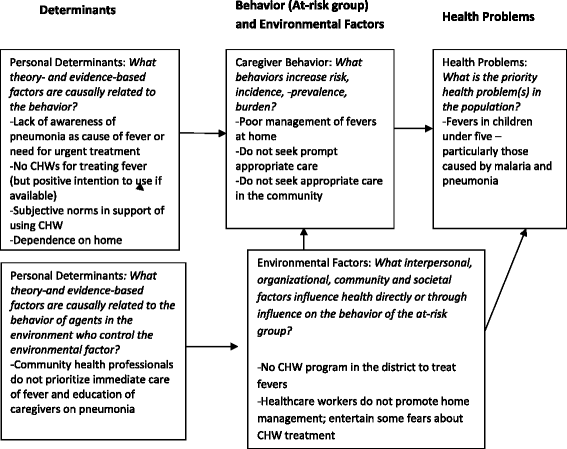Development of a theory and evidence-based program to promote community treatment of fevers in children under five in a rural district in Southern Ghana: An intervention mapping approach
- PMID: 28122594
- PMCID: PMC5267456
- DOI: 10.1186/s12889-016-3957-1
Development of a theory and evidence-based program to promote community treatment of fevers in children under five in a rural district in Southern Ghana: An intervention mapping approach
Abstract
Background: This paper describes the development and implementation of a program to promote prompt and appropriate care seeking for fever in children under the age of five. Designed as a multicomponent program, the intervention comprises elements to influence the behavior of caregivers of children, Community Health Workers, professional health care providers and the wider community.
Methods: Following the six fundamental steps of the Intervention Mapping protocol, we involved relevant stakeholders from the commencement of planning to program end. The IM protocol also recommends various behavior change methods to guide intervention development.
Results: The intervention components implemented were successful in achieving program goals. For example, the intervention resulted in the primary outcome of reductions in all-cause mortality of 30% and 44%, among children treated with an antimalarial and those treated with the antimalarial plus an antibiotic respectively. Most Community Health Workers were retained on the program, with an attrition rate of 21.2% over a period of 30 months and the Community Health Workers rate of adherence to performance guidelines was high at 94.6%.
Conclusion: We were able to systematically develop a theory- and evidence-based health promotion program based on the Intervention Mapping protocol. This article contributes to the response to recent calls for a more detailed description of the development of interventions and trials. The intervention mapping approach can serve as a guide for others interested in developing community- based health interventions in similar settings.
Keywords: Caregivers; Children under five; Community based program; Community health workers; Ghana; Intervention development; Intervention mapping.
Figures
References
-
- Christopher JB, Le May A, Lewin S, Ross DA. Thirty years after Alma-Ata: a systematic review of the impact of community health workers delivering curative interventions against malaria, pneumonia and diarrhoea on child mortality and morbidity in sub-Saharan Africa. Hum Resour Health. 2011;9(1):27. doi: 10.1186/1478-4491-9-27. - DOI - PMC - PubMed
-
- Lozano R, Wang H, Foreman KJ, Rajaratnam JK, Naghavi M, Marcus JR, Dwyer-Lindgren L, Lofgren KT, Phillips D, Atkinson C. Progress towards Millennium Development Goals 4 and 5 on maternal and child mortality: an updated systematic analysis. Lancet. 2011;378(9797):1139–1165. doi: 10.1016/S0140-6736(11)61337-8. - DOI - PubMed
-
- Rajaratnam JK, Marcus JR, Flaxman AD, Wang H, Levin-Rector A, Dwyer L, Costa M, Lopez AD, Murray CJL. Neonatal, postneonatal, childhood, and under-5 mortality for 187 countries, 1970–2010: a systematic analysis of progress towards Millennium Development Goal 4. Lancet. 2010;375(9730):1988–2008. doi: 10.1016/S0140-6736(10)60703-9. - DOI - PubMed
-
- World Health Organization: Guidelines for the treatment of Malaria Second edition. Geneva: WHO Press; 2010.
MeSH terms
LinkOut - more resources
Full Text Sources
Other Literature Sources
Medical


